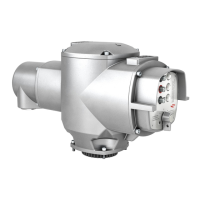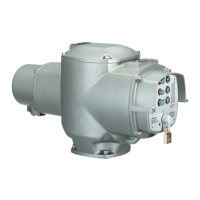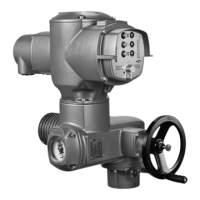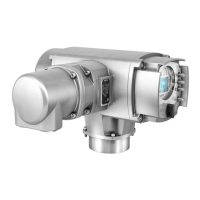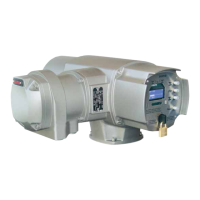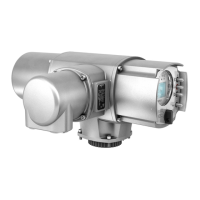Table 9:
Maximum permissible protection
max. protectionRated powerSwitchgear
(switchgear with power class)
1)
16 A (gL/gG)up to 1.5 kWReversing contactor A1
32 A (gL/gG)up to 7.5 kWReversing contactor A2
63 A (gL/gG)up to 15 kWReversing contactor A3
125A (gL/gG)up to 30 kWReversing contactor A4 (in control box)
200A (gL/gG)up to 55 kWReversing contactor A5 (in control box)
315A (gL/gG)up to 75 kWReversing contactor A6 (in control box)
16 A (g/R) I²t<1,500A²sup to 1.5 kWThyristor B1
32 A (g/R) I²t<1,500A²sup to 3 kWThyristor B2
63 A (g/R) I²t<5,000A²sup to 5.5 kWThyristor B3
The AUMA power class (A1, B1, ...) is indicated on the actuator controls name plate1)
If actuator controls are mounted separately from actuator (actuator controls on wall
bracket): Consider length and cross section of connecting cable when defining the
protection required.
External supply of the
electronics
If electronics is supplied externally with 24 V DC, the power supply is smoothed via
an internal 1,000 µF capacitor). When selecting the power supply, care must be
taken to consider the capacitor inrush current upon powering up the unit.
Safety standards
Safety measures and safety equipment must comply with the respectively valid
national on site specifications. All externally connected devices shall comply with
the relevant safety standards for the place of installation.
Connecting cables
●
We recommend using connecting cables and connecting terminals according
to rated current (I
N
) (refer to motor name plate or electrical data sheet).
●
For device insulation, appropriate (voltage-proof) cables must be used. Specify
cables for the highest occurring rated voltage.
●
Use connecting cable with appropriate minimum rated temperature.
●
For connecting cables exposed to UV radiation (outdoor installation), use UV
resistant cables.
●
For the connection of position transmitters, screened cables must be used.
Cable installation in ac-
cordance with EMC
Signal and fieldbus cables are susceptible to interference. Motor cables are
interference sources.
●
Lay cables being susceptible to interference or sources of interference at the
highest possible distance from each other.
●
The interference immunity of signal and fieldbus cables increases if the cables
are laid close to the earth potential.
●
If possible, avoid laying long cables and make sure that they are installed in
areas being subject to low interference.
●
Avoid parallel paths with little cable distance of cables being either susceptible
to interference or interference sources.
22
SA 25.1 – SA 48.1 / SAR 25.1 – SAR 30.1
Electrical connection AM 02.1

